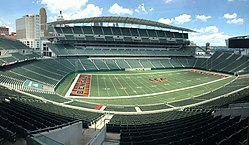"The Jungle" | |
 | |
 The stadium in June 2017 | |
Location in Ohio Location in the United States | |
| Former names | Paul Brown Stadium (2000–2021) |
|---|---|
| Address | 1 Paycor Stadium USA[1] |
| Location | Cincinnati, Ohio |
| Coordinates | 39°05′42″N 84°30′58″W / 39.095°N 84.516°W |
| Public transit | |
| Owner | Hamilton County |
| Operator | Cincinnati Bengals |
| Executive suites | 114 |
| Capacity | 65,515 |
| Record attendance | 67,260 (Bengals vs. Dolphins, Thursday, September 29, 2022)[2] |
| Surface | Kentucky Bluegrass (2000–2003) FieldTurf (2004–2011) Act Global synthetic turf (2012–2017) Shaw Sports Momentum Pro (2018–present)[3] |
| Construction | |
| Broke ground | April 25, 1998[4] |
| Opened | August 19, 2000 24 years ago |
| Construction cost | $455 million ($805 million in 2023 dollars[5]) |
| Architect | NBBJ[6] Glaser Associates Inc.[6] Moody Nolan[6] Stallworth Architecture Inc.[6] |
| Project manager | Getz Ventures[7] |
| Structural engineer | Ove Arup/Graham, Obermeyer[6] |
| Services engineer | Flack & Kurtz, Inc.[6] |
| General contractor | TBMD Joint Venture (Turner/Barton Malow/D.A.G.)[6] |
| Tenants | |
| Cincinnati Bengals (NFL) (2000–present) Cincinnati Bearcats (NCAA) (2014) | |
Paycor Stadium, previously known as Paul Brown Stadium, is an outdoor football stadium in Cincinnati, Ohio. It is the home venue of the Cincinnati Bengals of the National Football League (NFL) and opened on August 19, 2000.
Originally named after the Bengals' founder, Paul Brown, the stadium is currently sponsored by Paycor, is located on approximately 22 acres (8.9 ha) of land, and has a listed seating capacity of 65,515. The stadium is nicknamed "The Jungle";[8] the Guns N' Roses song "Welcome to the Jungle", is the team's unofficial anthem due in part to the nickname.[9]
The construction of the stadium included $555 million of public funding, the largest public subsidy for an NFL stadium at the time.[10] The Bengals had threatened to leave Cincinnati unless the city agreed to subsidize the stadium.[10] In 2011, The Wall Street Journal described the stadium deal as "unusually lopsided in favor of the team and risky for taxpayers."[10] Since then, additional costs have been imposed on taxpayers related to the stadium.[11] By one estimate, taxpayers will have paid $1.1 billion by 2026, the year in which the 26-year deal expires.[11]
- ^ "Paul Brown Stadium". Archived from the original on 2023-03-14. Retrieved 2023-03-14.
- ^ Cite error: The named reference
facts and statswas invoked but never defined (see the help page). - ^ "Cincinnati Bengals – Paul Brown Stadium – Shaw Sports Turf". Archived from the original on 2023-09-19. Retrieved 2018-07-26.
- ^ "Bengals Break Ground on New Stadium". Portsmouth Daily Times. April 26, 1998. Archived from the original on September 19, 2023. Retrieved December 2, 2020.
- ^ 1634–1699: McCusker, J. J. (1997). How Much Is That in Real Money? A Historical Price Index for Use as a Deflator of Money Values in the Economy of the United States: Addenda et Corrigenda (PDF). American Antiquarian Society. 1700–1799: McCusker, J. J. (1992). How Much Is That in Real Money? A Historical Price Index for Use as a Deflator of Money Values in the Economy of the United States (PDF). American Antiquarian Society. 1800–present: Federal Reserve Bank of Minneapolis. "Consumer Price Index (estimate) 1800–". Retrieved February 29, 2024.
- ^ a b c d e f g "Architects, Contractors and Subcontractors of Current Big Five Facility Projects". Archived from the original on 2015-06-22. Retrieved 2012-02-26.
- ^ "Cincy Stadium Contracts Awarded for Architects/Management". Archived from the original on 2020-12-02. Retrieved 2012-03-15.
- ^ "Bengals Fans, It's Time to Rule The Jungle!". Bengals.com. Archived from the original on 2023-06-07. Retrieved 2023-05-01.
- ^ "Guns N' Roses is about to make more money in Cincinnati: Creating a Bengals music playlist". Cincinnati.com. Archived from the original on 2022-04-13. Retrieved 2023-05-01.
- ^ a b c Albergotti, Reed; McWhirter, Cameron (2011-07-12). "Stadium's Costly Legacy Throws Taxpayers for a Loss". Wall Street Journal. ISSN 0099-9660. Archived from the original on 2013-06-04. Retrieved 2023-12-13.
- ^ a b "Bengals stadium has cost taxpayers $920 million". WCPO 9 Cincinnati. 2016-01-18. Archived from the original on 2023-12-13. Retrieved 2023-12-13.

